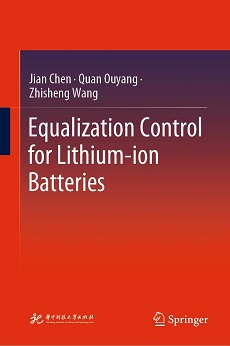内容简介:
This book provides readers with sufficient insight into battery equalization control technologies from both theoretical and engineering perspectives. Distinguished from most of the existing works that focus on the hardware design of active equalizers, this book intends to comprehensively introduce equalization control strategies for lithium-ion battery packs. The validity and reliability of the control strategies in this book have been verified by theory and experiments.
This book summarizes the battery equalization technologies from the equalization system to the equalization control algorithm. From this book, readers who are interested in the area of battery management can have a broad view of cell equalization technologies. Readers who have no experience in the battery management area can learn the basic concept, analysis methods, and design principles of the cell equalization system for battery packs. Even for the readers who are occupied in this area, this book provides rich knowledge on engineering applications and future trends of battery equalization control.
英文目录:
1 Introduction
1.1 Applications of Lithium-Ion Batteries
1.1.1 The Crucial Role of Batteries
1.1.2 Comparisons of Different Batteries
1.2 Battery Inconsistency Phenomenon
1.3 Crucial Role of Cell Equalization
1.3.1 Voltage-Based Equalization
1.3.2 SOC-Based Equalization
References
2 Overview of Cell Equalization Systems
2.1 Classification and Comparisons of Cell Equalization Systems
2.1.1 Passive Cell Equalization Systems
2.1.2 Active Cell Equalization Systems
2.1.3 Comparisons of Cell Equalization Systems
2.2 Commercial Equalizers
2.2.1 Bidirectional Buck-Boost Converters
2.2.2 Bidirectional Modified Cuk Converters
2.3 Overview of Equalization Algorithms
2.3.1 Cell-to-Cell Equalization Algorithms
2.3.2 Cell-to-Pack-to-Cell Equalization Algorithms
2.3.3 Charging Equalization Algorithms
References
3 Active Cell Equalization Topology
3.1 Commonly Used Active Cell Equalization Topology
3.1.1 Adjacent-Based Topology
3.1.2 Non-adjacent-Based Topology
3.1.3 Direct Cell-Cell Topology
3.1.4 Mixed Topology
3.2 Active Cell Equalization Topology Comparison
3.2.1 Performance Comparison
3.2.2 Economic Comparison
3.2.3 Discussions
References
4 Optimal Active Cell Equalizing Topology Design
4.1 Cell Equalizing System
4.1.1 Equalizing System Model
4.1.2 Consensus-Based Cell Equalizing Algorithm Design
4.2 Design of the Optimal Equalizing Topology
4.2.1 Equalizing Time
4.2.2 Traditional Cell Equalizing Topology
4.2.3 Position Identification of the Added ICEs for Reducing the Equalizing Time
4.3 Simulation Results
4.4 Experimental Results
References
5 Neural Network-Based SOC Observer Design for Batteries
5.1 Battery Model
5.2 RBF Neural Network Observer
5.2.1 Neural Network Based Nonlinear Observer Design
5.2.2 Convergence Analysis
5.3 Experiments and Simulations
5.3.1 Experiment for Parameter Extraction
5.3.2 Experiment for SOC Estimation
References
6 Active Cell-to-Cell Equalization Control
6.1 Cell Equalizing System Model
6.1.1 Battery Cell Model
6.1.2 Bidirectional Modified Cuk Converter Model
6.1.3 Cell Equalizing System Model
6.2 Objective and Constraints of the Cell Equalizing Process
6.2.1 Cell Equalizing Objective
6.2.2 Cell Equalizing Constraints
6.3 SOC Estimation Based Quasi-Sliding Mode Control for Cell Equalization
6.3.1 Adaptive Quasi-sliding Mode Observer Design for Cells’ SOC Estimation
6.3.2 Quasi-Sliding Mode-Based Cell Equalizing Control
6.4 Experiments
6.4.1 Experimental Setup
6.4.2 Experimental Results
References
7 Module-Based Cell-to-Cell Equalization Control
7.1 Module-Based Cell-to-Cell Equalization Systems
7.1.1 Equalizing Currents
7.1.2 Cell Equalizing System Model
7.1.3 Cell Equalizing Constraints
7.2 Hierarchical Optimal Control Strategy
7.2.1 Cell Equalizing Task Formulation
7.2.2 Top Layer: Module-Level Equalizing Control
7.2.3 Bottom Layer: Cell-Level Equalizing Control
7.3 Results and Discussions
7.3.1 Cell Equalizing Results
7.3.2 Tests of Different Weight Selections
7.3.3 Comparison With Decentralized Equalizing Control
7.3.4 Tests for Different Cells’ Initial SOCs
References
8 Module-Based Cell-to-Pack Equalization Control
8.1 Improved Module-Based CPC Equalization System
8.1.1 Equalizing Current Formulation
8.1.2 Improved Module-Based CPC Equalization System Model
8.2 Two-Layer Model Predictive Control Strategy
8.2.1 Cost Function Formulation
8.2.2 Constraints
8.2.3 Centralized MPC Design
8.3 Two-Layer MPC for Cell Equalization
8.3.1 Top-layer MPC: ML Equalizing Current Control
8.3.2 Bottom-Layer MPC: CMC Equalizing Current Control
8.3.3 Computational Complexity Comparison With Centralized MPC
8.4 Results and Discussions
8.4.1 Equalization Results
8.4.2 Comparison With the Centralized MPC
8.4.3 Comparison With a Commercial CPC-Based Equalization Structure
8.4.4 Tests of Different Cells’ Initial SOC Vectors
References
9 Optimal Hierarchical Charging Equalization for Battery Packs
9.1 Charging System Model
9.1.1 Battery Pack Model
9.1.2 Multi-module Charger Modeling
9.1.3 Charging System Modeling
9.2 Hierarchical Control for the Charging Equalization System
9.2.1 Charging Equalization Objectives
9.2.2 Charging Constraints
9.2.3 Top-Layer Control: Optimal Charging Current Scheduling
9.2.4 Bottom-Layer Control: Charging Current Tracking
9.3 Simulation and Experimental Results
9.3.1 Simulation Results
9.3.2 Experimental Results
References
10 Simultaneous Charging Equalization Strategy for Battery Packs
10.1 Charging Model
10.1.1 Battery Pack Modeling
10.1.2 Charging Objective
10.1.3 Charging Constraints
10.2 Simultaneous Charging Development
10.3 Simulation and Experimental Results
10.3.1 Simulation Results
10.3.2 Experimental Results
References

